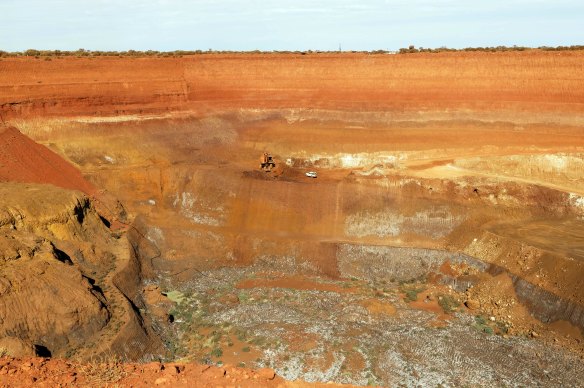Five long-term stock picks from Australia’s biggest funds
Five fund managers at some of Australia’s largest investment firms have given their best stock picks for investors looking over the long term.
They all manage funds on a pro bono basis for Future Generation Australia, an investment firm that does not charge fees and donates 1 per cent of its assets to not-for-profit partners. Since 2014, the fund has donated $65 million to various charities which support at-risk youth.
Six fund managers at some of Australia’s largest investment firms have given their best stock picks for investors looking over the long term.Credit:Louie Douvis
The Age and The Sydney Morning Herald analyse stocks each Wednesday through our Long and Short of It column.
Siemens Energy (ENR.DE)
Fund manager: Andy Gibson, sector head at Antipodes Partners
What does the company stand for? Siemens Energy was spun out of Siemens AG in 2020. It holds a dominant position in the provision of energy infrastructure while supplying most of the world’s offshore wind turbines.
The Global Wind Energy Council expects wind will provide up to 20 per cent of electricity by 2030. Credit:Getty
Why this stock? If the world is to meet its climate goals, it will require a multi-decade investment super-cycle in decarbonisation, with many intermediate steps necessary to reach the net-zero end goal. Siemens Energy has a uniquely comprehensive and well-rounded portfolio of offerings that deliver meaningful abatement at every stage of this transition. It is also one of the cheapest, and most mispriced, decarbonisation plays in the market today.
Siemens Energy’s gas turbines can pivot to using hydrogen as their fuel source – hydrogen which could be produced with their electrolysers. The company’s high-voltage transmission portfolio allows renewable sources to be connected to the grid, which it helps stabilise. Those grid connections are a requirement given the Global Wind Energy Council expects wind will provide up to 20 per cent of electricity by 2030, which Siemens Energy’s products will have no small part in supplying.
Your take on the stock: Siemens Energy is trading at attractive valuations and has multiple ways of winning. It offers decarbonisation solutions across the energy value chain and the technologies to make the future energy grid robust. The company has a near €100 billion ($153 billion) order backlog, which is more than three times annual revenue versus a market cap of €14 billion, of which well over half is in long-duration service contracts which carry higher profitability.
Supply chain issues that weighed on the business pushed Siemens Energy down to very attractive valuations. It trades at around five times our estimated 2025 enterprise multiple to earnings ratio. It may well be the last cheap decarbonisation play.
Why is this a long-term stock? Given the favourable global policy backdrop which has earmarked vast sums for energy security and climate initiatives, we see multiple positive catalysts for re-rating.
Capstone Copper (TSE:CS)
Fund manager: Rafi Lamm, joint managing director & chief investment officer at L1 Capital
Capstone is a Canadian headquartered, high-quality copper miner.Credit:Robert Rough
What does the company stand for? Capstone is a Canadian headquartered, high-quality copper miner with a portfolio of long-life operating assets across several mining-friendly jurisdictions in the Americas.
Why this stock? Capstone has an exceptional growth profile with a pipeline of fully permitted projects that will enable it to more than double production from 185 kilotons (kt) to close to 400kt over the next few years. Despite this strong growth outlook, Capstone trades on only 7.2 times consensus FY24 price-to-earnings ratio and has the most attractive growth profile of its peer group.
Your take on the stock: We think Capstone will have a major positive inflection in 2024 as capital expenditure rapidly declines, production increases and the copper price rises. Capstone is fully funded to complete the currently approved project pipeline and has a highly capable, focused and aligned management team. If the management team deliver the MVDP sulphide expansion as planned, we believe there is more than a 100 per cent upside to the current share price over the next few years. The company also has an attractive suite of copper and cobalt growth opportunities under feasibility studies, which could provide further value creation opportunities.
Why is this a long-term stock? We believe Capstone offers both strong production growth and leverage to an improving copper price. We are very positive on the long-term fundamentals of copper where market forecasts indicate a major and sustained copper deficit is likely in the next few years. Copper demand is expected to structurally increase as the copper-intensive global energy transition gains momentum.
Copper supply, however, is expected to remain constrained given lengthy mine development timeframes and reduced capital expenditure investment.
Compagnie Financiere Richemont (Richemont) (CFR.SW)
Fund manager: Jeremy Gibson, portfolio manager at Munro Partners.
What does the company stand for? Richemont is a luxury goods conglomerate based in Switzerland. Through its various subsidiaries, Richemont manufactures and retails jewellery, watches, leather goods, writing instruments, as well as apparel. Brands within the stable include Cartier (jewellery), Piaget (watches), Montblanc (writing instruments) and Dunhill (apparel). Cartier, the largest brand, is regarded as one of the most prestigious jewellery manufacturers in the world. Its heritage dates to 1874, and it has a long history of sales to royalty, including King Edward VII.
Why this stock? Within the consumer discretionary sector, we see luxury goods as the best place to be positioned. Luxury goods are very resilient in an economic downturn as the customer base is less sensitive to economic conditions. The best luxury goods companies, of which Richemont is one of the leaders, have strong pricing power given the heritage of their brands cannot be replicated, and the customers are not particularly price sensitive. Given this pricing power, the industry is well-positioned to weather rising inflation as it can pass on the costs. Given the industry has high gross margins, only a small price increase is required to offset a larger increase in the raw material costs.
Your take on the stock: Richemont is a core luxury goods stock, and we see upside to earnings estimates and their multiple, along with upcoming catalysts, the key ingredients we look for in a stock.
Revenue estimates have the company growing sales by 6 per cent in their next financial year (Mar-2024). We would expect that pricing alone would be enough for the group to grow sales by 6 per cent. The big upside comes from the return of the Chinese consumer. In 2019, the Chinese consumer made up 37 per cent of revenue, compared to just 23 per cent in 2022. With the re-opening of the Chinese economy and borders, we would expect material growth coming from China on weak comparison numbers, which would see the revenue growth blow past this 6 per cent consensus number.
Lynas Corporation’s Mount Weld rare earth mine in Western Australia.Credit:Trevor Collens
Why is this a long-term stock? We believe in the long-term theme of luxury goods, with China continuing to be a key growth driver, supplemented by the US consumers discovering luxury goods in a more meaningful way and, longer term, Saudi Arabian/Middle East consumers becoming a third leg to the growth story.
Lynas Rare Earths (LYC-AU)
Fund manager: Tom Richardson, portfolio manager at Paradice Investments
What does the company stand for? The Lynas values of care, achievement, expertise, diversity and sustainability guide their decision-making. The company is recognised as a leading supplier of sustainable rare earth materials.
Why this stock? The energy transition requires a large amount of rare earth materials. Lynas is blessed with one of the best ore bodies in the world and has considerable management experience to deliver on the opportunity.
Your take on the stock: Lynas is developing a globally significant rare earths business. They hold a unique position as the only scale producer outside of China. The company has a strong balance sheet to continue investing in its downstream assets and through (hard-earned) experience is a global leader.
Why is this a long-term stock? Commodities can be volatile and rare earth is no different. 2023 may see more volatility as global demand weakens in response to rising interest rates. Longer term, the rare earth price will need to be high enough to incentivise new production which will support the earnings and growth potential for Lynas.
Telstra (TLS)
Fund manager: David Prescott, managing director and portfolio manager at Lanyon
What does the company stand for? Telstra is Australia’s leading telecommunications company, building and operating telecom networks and marketing voice, mobile, internet access, pay television and other products and services. Telstra is the largest wireless carrier in Australia and has recently focused on diversified products and emerging technologies.
Why this stock? We rarely find mispricings in the very large end of the Australian market, which is often well covered and somewhat efficiently priced. However, Telstra is a mispriced opportunity with, in our view, a significant near-term catalyst.
Telstra is Australia’s leading telecommunications company, building and operating telecom networks and marketing voice, mobile, internet access, pay television and other products and services.Credit:Glenn Campbell
Your take on the stock: In October, Telstra shareholders approved a significant corporate restructure into four separate subsidiaries. The key reason for the complex separation, in our view, was to separate the infrastructure assets from the retail and wholesale business.
We think a sale of the infrastructure assets is imminent, most likely a sale of 49 per cent of the assets to Australian institutional investors, who will more highly value these income streams than Telstra shareholders.
This sale is likely to realise substantial value for Telstra shareholders which may exceed one-third of the company’s current market cap. We think a sale of these assets is imminent and in our view will underpin one of the largest share buybacks the Australian market has seen.
Why is this a long-term stock? Telstra is the dominant provider of telco services, an industry with strong long-term structural tailwinds. Digitisation in the home, the workplace and economies more broadly will continue to grow and reinforces the importance and value of the telecommunications infrastructure and connectivity that enables that digitisation.
- Advice given in this article is general in nature and is not intended to influence readers’ decisions about investing or financial products. They should always seek their own professional advice that takes into account their own personal circumstances before making any financial decisions.
Most Viewed in Money
From our partners
Source: Read Full Article





